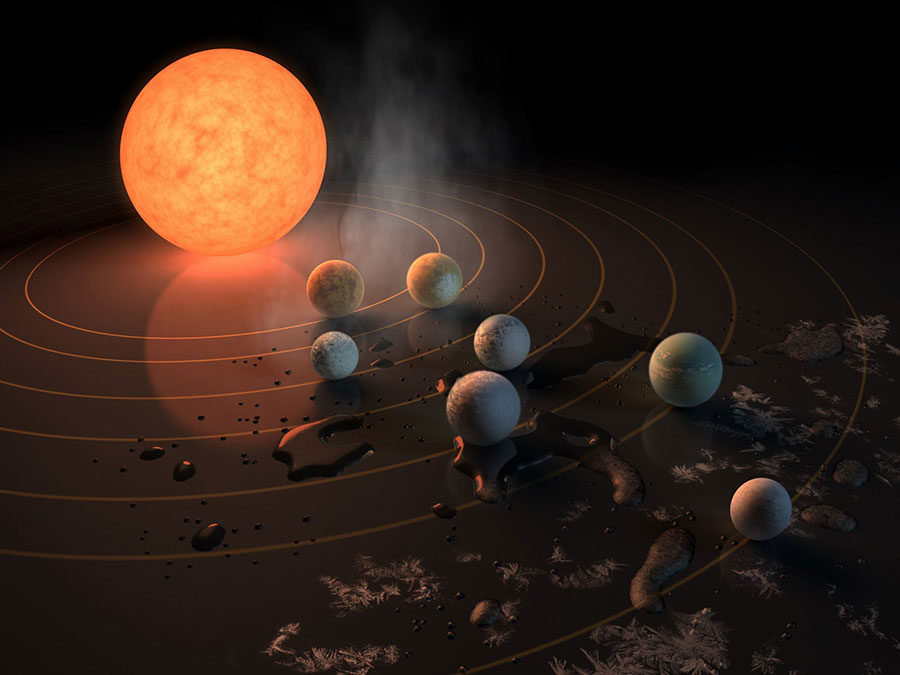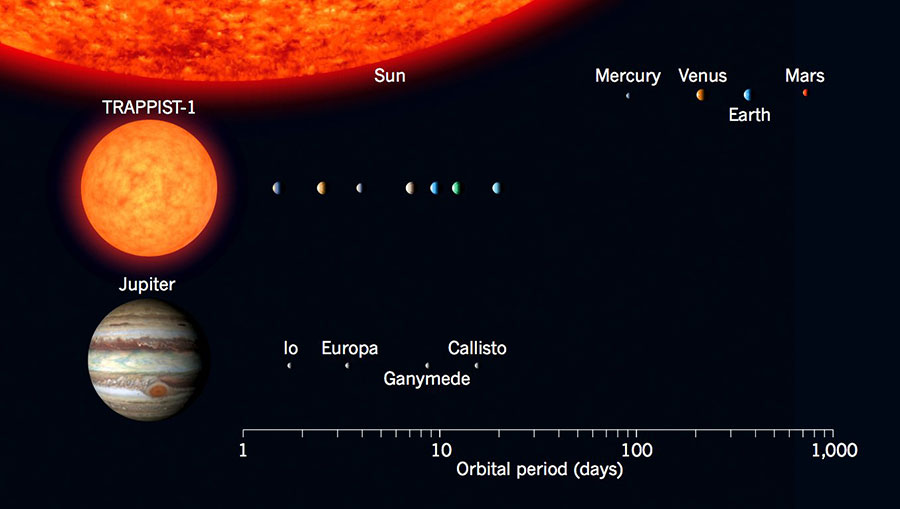NASA announced this Wednesday at a news conference held in Washington the discovery of a new solar system with seven Earth-sized planets that could be habitable for humans, based on preliminary investigations.
According to the study published in the journal Nature, the discovered planets are orbiting around the same star, like the planets in our solar system. This system is located about 40 light-years away. This newly discovered system is quite impressive and rare since its planets are similar to Earth in several aspects, as they are temperate, which means that it could be the suitable for water and life.

According to Michaël Gillon, lead author, and astronomer at the University of Liège, “this is the first time that so many planets of this kind are found around the same star.”
The star that hosts the discovered exoplanets is called TRAPPIST-1, and it was qualified as an ultracool dwarf star.
Initial findings showed that these exoplanets are rocky, unlike other planets like Jupiter that are more gaseous. Three of those planets could be suitable to sustain life, as even water formations like oceans could be present on their surfaces.
Back in May, the discovery of TRAPPIST-1 was announced by NASA, along with the three first exoplanets seen by astronomers. With this new publication, this number rose up to 7.
“I think we’ve made a crucial step towards finding if there is life out there,” said Amaury Triaud, one of the study authors and an astronomer at the University of Cambridge. “I don’t think any time before we had the right planets to discover and find out if there was (life). Here, if life managed to thrive and releases gases similar to what we have on Earth, we will know.”
Even when these discoveries do not accomplish NASA’s main goal of finding life beyond Earth, it is a great achievement.
Researchers have stated that life might initiate and evolve differently in other areas of the universe. Finding important pieces of information like the presence of gasses is key to discover signs of life anywhere in outer space.
According to Thomas Zurbuchen, associate administrator for NASA’s Science Mission Directorate, these discoveries represent a “significant piece in the puzzle of finding habitable environments,” as they think they are closer to unraveling the mystery of life beyond Earth.
He explained that the “Are we alone?” question is a top priority for space investigations centers all around the globe, as the discovery of more planets where life could be suitable makes the answer more possible than ever.

Principal findings of the astronomers’ investigation
Sara Seager, professor of planetary science and physics at Massachusetts Institute of Technology, states that if there is an exoplanet, this automatically means that there are more nearby.
Seager and her colleagues are enthusiastic about this discovery as they are getting better on knowing where to look to find a planet that is similar to Earth.
One particular characteristic of the discovered exoplanets is that they are very close to the others, granting the possibility for researchers to analyze more deeply their features.
The orbits of the planets present a notable variety, as the nearest planet to TRAPPIST-1 rotates in half day, while one of the farthest takes almost 14 days. The orbit of the most distant planet recognized was not determined.
According to preliminary results, this star does not provide as much light as our Sun, for example. If a person stands on the surface of one of the exoplanets, it will receive about 200 times less light than in Earth.
However, due to the proximity of the planets with the star, the amount of energy is still enough to keep a person warm. Also, a person standing in one of the surfaces could see the other planets like big moons, as they would seem like twice as large as our natural satellite.
To obtain all the study’s results, researchers used the TRAnsiting Planets and PlanetesImals Small Telescope or TRAPPIST. This telescope can perceive starlight and its corresponding changes even at moments of full brightness. The investigation team detected a series of shadows that appeared periodically like they were eclipses. These shadows were produced by the planets, as further observations proved.
The next goal for NASA is to define the characteristics of each planet’s atmospheres. As well, they want to confirm the possible presence of water on their surfaces.
“This is the most exciting result I have seen in the 14 years of Spitzer operations,” said Sean Carey, manager of NASA’s Spitzer Science Center at Caltech/IPAC in Pasadena, California. “Spitzer will follow up in the fall to further refine our understanding of these planets so that the James Webb Space Telescope can follow up. More observations of the system are sure to reveal more secrets.”
Source: CNN
